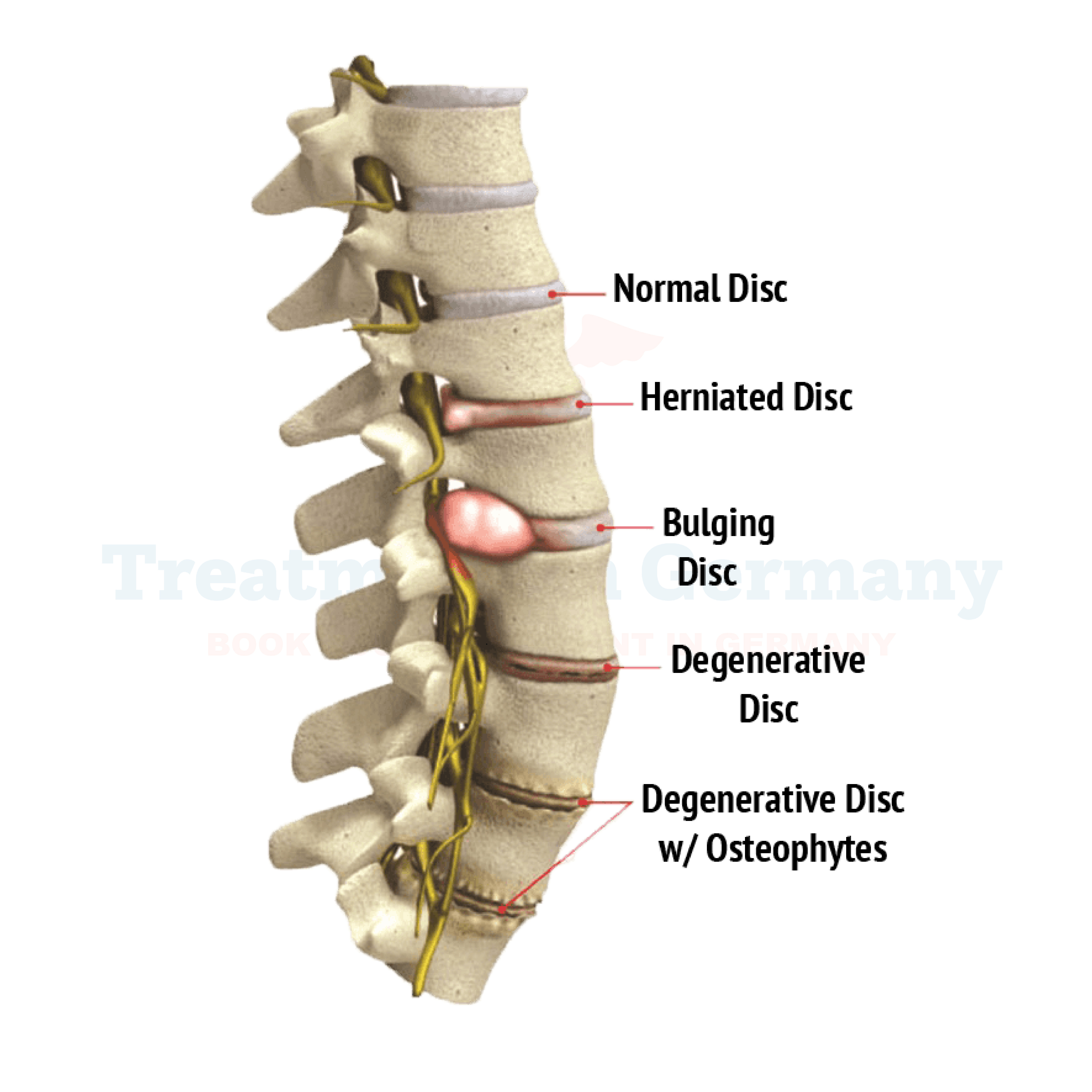The slow degradation of the intervertebral discs, which are circular discs that sit between the spine's vertebrae, causes degenerative disc disease. While DDD is a normal ageing process, the manifestation in the lumbar spine we see in current-day practice presents as severe debilitating pain and reduced mobility with profound effects on activities of daily living.
Germany has become one of the world’s leading countries in the use of modern, sophisticated therapies for DDD, contributing both non-surgical and surgical approaches.
Degenerative disc disease, however, is not a disease but simply the aging of spinal discs as they become degenerate over time. These discs act as spacers that offer cushioning to the spine to allow for relative flexing and turning of the back. With age, they become less elastic and moist, and in this regard, they afford little shock absorption besides several possible risks and consequences.
Common Complications
These are some of the typical DDD complications:
Who is at Risk?
Degenerative Disc Disease usually occurs in people who are 40 years old and older. Several factors can increase the risk of developing this condition:
Common signs of the disease are the same as general lower back pain, but they can become chronic and worsen over time.
Symptoms of Degenerative Disc Disease
In this condition, symptoms depend on the type and location of the disc derangement, where DDD is most commonly seen in the lumbar region.
Diagnosis of Degenerative Disc Disease in Germany
Therefore, accurate diagnosis necessitates early discovery and needs to be carried out correctly. Medical facilities in Germany use advanced equipment to diagnose and stage DDD.
Imaging Tests:
Physical Examination: Doctors evaluate
Medical History Review:
The existence, nature, and extent of prior injuries, family history, and activity levels are questions relevant to diagnosis.
Non-Surgical Treatments in Germany
Germany is famous for providing a full range of non-surgical DDD treatments, with a focus on approaches that involve minimal pain and time for recovery.
Physical Therapy
This is essential, as physical therapy is crucial in managing the DDD. Stretches are provided to focus the muscles that keep the spine erect, as well as to relieve tension on precise regions in the back.
Patients may be prescribed:
Analgesic, antipyretic, and anti-inflammatory drugs, more specifically nonsteroidal inflammatory drugs (I).
Skeletal muscle relaxants help to release tension within the neighboring muscles.
Steroid Injections
Oral steroids help to decrease spinal cord swelling, and while injected directly into the patient near the involved spinal nerves, injections help to relieve the pain for some time.
Innovative Techniques
The innovative techniques of DDD are as follows:
Surgical Treatments in Germany
Surgery might be the best course of action for patients with severe DDD or those who do not improve with conservative therapy. Germany’s surgeons are known for their skill and innovative methods.
Types of Surgical Procedures
The following are the many kinds of surgical procedures:
Spinal Decompression Surgery
Spinal Fusion
This procedure makes a spine stable by joining two or more vertebrae, thus decreasing the pain and avoiding further instability.
Artificial Disc Replacement
Entails using an advanced form of surgery where a metal or plastic disc is inserted to replace the worn-out disc and allow normal bending of the spine.
Benefits of DDD Treatment in Germany
Germany is a preferred destination for DDD treatment due to:
Prevention of Degenerative Disc Disease
While aging is unavoidable, several steps can help prevent or slow the progression of DDD:
Frequently Asked Questions
Why is going to Germany preferable when you need DDD treatment?
The liberal health care system in Germany, the presence of state-of-the-art equipment, and highly skilled doctors firmly establish Germany on this front.
What are the non-invasive approaches to the treatment of DDD?
Some of the conservative approaches to managing an arthritic hip are physical therapy, non- steroidal anti-inflammatory drugs, cortisone shots and novel techniques such as radiofrequency neurotomy.
How can I determine if I require DDD surgery?
Operations are used when other approaches do not help to reduce pain or when nerve damage threatens the ability to walk or have muscle power.
Is it possible to modify lifestyle strategies in the management of DDD?
Yes, there are factors that one could do to overcome the symptoms and possibly even slow down the advancement of the disease; they include maintaining a healthy weight and also refusing to smoke. Low-impact exercises also do help.
How much time does it take to recover from DDD surgery?
The recovery period does vary with the specific surgery but commonly is from a few weeks for outpatient surgery to several months for major surgery.
👉 Contact us for further information and receive a complimentary consultation.

.webp)
.webp)
 (1).webp)
 (1).webp)

.webp)
.webp)
 (1).webp)
 (1).webp)
